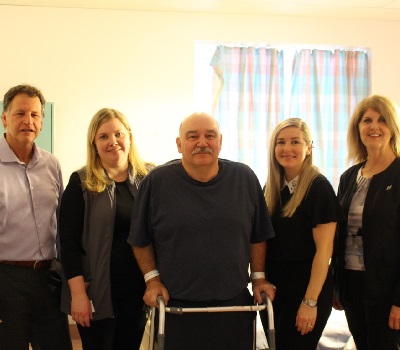
By Krista Wood
When Laurel MacInnis completed the University of Toronto’s Bachelor of Science Physician Assistant degree she didn’t know if she would have the chance to practice in her home province of Nova Scotia.
“I am passionate about orthopedics, acute care, sports medicine and providing quality care to patients,” said MacInnis.
After years working in Ontario, she made history this year, becoming the first physician assistant in Nova Scotia outside of the Canadian Forces.
Nova Scotia Health is collaborating with the College of Physicians and Surgeons of Nova Scotia to pilot the physician assistant role.
Together they are evaluating how it may help build capacity, improve care and increase access to hip and knee joint replacement surgeries.
Two additional physician assistants, Erin Sephton and Brittany Belair, have also recently returned home to Nova Scotia, joining the QEII Health Sciences Centre (QEII) orthopedics team.
The trio is supporting patients at the QEII’s Halifax Infirmary (HI) site and Dartmouth General Hospital (DGH). This includes providing general medical care and supporting surgical care, including consultations, surgery, post-surgical care, discharge and follow-up care.
“All three physician assistants have practiced orthopedics care in Ontario and their advice, support and clinical experience is welcome as we work to build on our recent gains and successes in delivering joint care,” said Joanne Dunnington, director of Perioperative (Surgical) Services, Pain Services and the Regional Tissue Bank for Nova Scotia Health's Central Zone (Halifax area, West Hants and Eastern Shore).
Funding for these and other roles was added under Nova Scotia Health's Hip and Knee Action Plan.
In October 2017 Nova Scotia Health received provincial government support for the multi-year plan that tackles numerous factors needed to improve joint replacement access and care.
It builds on other efforts with sustained investments that are transforming how we manage and deliver these services, including a new wellness model and intake process launched in the fall of 2018.
Four new orthopedic surgeons, three new anesthesiologists and more than 90 additional full-time positions have been added, including nurses, dietitians, physiotherapists and others.
It has allowed for other innovative and enabling roles, including the province’s first orthopedic registered nurse first assistants (RNFA) and Cape Breton’s first orthopedic nurse practitioner.
Two registered nurses from Cape Breton were funded to complete the Mohawk College RNFA program in Ontario.
While a small number of RNFAs support other surgical sub-specialties, Jeff Hardy and Matthew Rizzato became the first to support orthopedic surgery. The roles were identified as a priority for Cape Breton Regional Hospital (CBRH) and could expand to other sites over time.
Their roles are complementing the work of the handful of family physicians who have historically assisted surgeons as family physician surgical assistants at CBRH.
Within operating rooms (ORs), RNFAs practice beyond the scope of traditional operating room nurses, assisting with surgeries under a surgeon’s direct supervision. This can include handling tissue, helping expose tissues and structures, using instruments, suturing and helping control bleeding.
They can help reduce the length of surgery and time patients are sedated. RNFAs also help free-up surgeons from some of their typical responsibilities outside ORs, to focus on other needs.
Last year Nova Scotia Health also launched a surgical nurse practitioner role within the elective orthopedic inpatient unit at CBRH. Modelled after similar roles at DGH and the IWK Health Centre, it has proven to be a valuable addition.
Orthopedic surgeon Dr. Don Brien believes the role has been a major improvement for patients, surgeons and nurses.
“This has been a real game changer for us in terms of running an efficient orthopedic service,” said Dr. Brien.
Nurse practitioner Serena Parsons was initially hired into the role in the spring. When she went on maternity leave, Crystal Robinson stepped in where she left off.
“They have increased capacity, reducing our demand and reliance on surgeons and increasing the support available to our patients and nursing team,” said Mary Parago, unit manager and registered nurse.
They can order pain medication, assess and admit emergency department patients with injuries like a hip fracture and spend more time with patients answering questions and educating them on what to expect after they go home.
“This has completely changed the number of calls I get from nurses on the inpatient unit and has expedited the care that our patients receive,” said Dr. Brien.
The successful introduction of this role has resulted in the approval to keep two nurse practitioners to support patients after surgery.
Improving access and care for hip and knee joint replacement patients has remained on NSHA’s list of top priorities since it was formed in 2015.
Flash forward five years and significant progress has been made to improve access and transform care.
Patients are having more timely initial assessments and receiving prehabilitation to help optimize them for surgery.
As of March 31, hip and knee joint replacements were up 25 per cent from 2015-16 and there were also nearly 18 per cent fewer long waiters (patients who have waited a year or more for surgery) on the provincial wait list.
“These are more than stats; there are people behind these numbers,” said Dr. Greg Hirsch, senior medical director of Nova Scotia Health’s Perioperative (Surgical) Services program.
“We know that Nova Scotians living with hip or knee problems can be in pain, have trouble getting around, lose time from work and be kept from activities they enjoy. Improving our numbers means improving more lives.”
Note: Prior to COVID-19, Nova Scotia Health had been making steady progress increasing hip and knee joint replacement surgeries, decreasing long waits and helping more Nova Scotians receive these surgeries within the national benchmark. Orthopedics surgeries were the second most impacted by COVID-19 service reductions. Of the scheduled surgeries that were postponed, nearly 20 per cent were orthopedics, many of which were planned hip or knee joint replacements. As we work to gradually increase surgeries and plan to respond to the backlog of cases, access to joint replacements, and other priority services, will be a key consideration.
